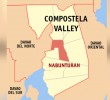Few Kidapawanons know the official motto of Kidapawan city, much less understand what it means.
‘Nakapangyayari ang sambayanan’ is banderoled on the city’s official seal, just below the escutcheon. The seal, designed by then Tourism Officer Benjamin Mallorca, was adopted by Kidapawan when it became a city in 1998. I have yet to find any official documents pertinent to the motto, but because I cannot find any use of it before 1998 I’m assuming it was also adopted upon cityhood.
The rather lofty Tagalog motto officially translates to ‘the people are sovereign’ (see the first few words of the Constitution’s preamble in Tagalog: ‘Kami, ang nakapangyayaring sambayanang Pilipino…’). It’s a metaphysical statement of nationhood: the word for sovereignty, ‘nakapangyayari,’ is rooted in the word ‘yari,’ ‘composition,’ but the morphology makes it an active state, ‘we who constitute.’ Sovereignty in Tagalog is implied to be active composition, thus making Kidapawan’s motto more literally ‘the people can constitute.’
But ‘nakapangyayari’ has another possible morphological derivation, leading to a more interesting alternative translation to the motto: ‘pangyayari’ also means ‘happening.’
The motto can thus also be translated: ‘The people can make it happen.’
Lovely idealism, you might think, one of those DepEd or DoH mandated themes that far too often are more the stuff of essay-writing contests for public school students that of any actual practice.
Kidapawan, in particular, has often shown that it is not the people but its government – the detached bureaucracy headed by the winning oligarch of the day – which makes things happen. The environment and natural resources are managed by the government. Law and order is the exclusive responsibility of the government. Festivals are organized by the government. The bulk of the education sector is run by the government. We rely, for everything, on the government, and so the government does everything.
But one recent development shows that, when they try, people can and often do make things happen.
This development, quite remarkably, is in another of those hollow principles we so often take for granted: the city’s history.
While Davao celebrated August with the Kadayawan festivities, on the other side of Mt Apo there were two celebrations in my hometown: the annual Timpupo Fruits Festival, and the town’s foundation anniversary.
The fruits festival was muted owing to the meager harvest (Kidapawan’s fruit industry is still picking up from the poor yield of the past decade), but the foundation was specially poignant. Not only was it a celebration of Kidapawan’s seventieth year, it was a celebration made possible by the efforts of its people.
You see, for the past decade or so, Kidapawan’s local government celebrated ‘foundation day’ on February 12. On this date in 1998, Fidel Ramos signed into law Republic Act 8500, declaring the Municipality of Kidapawan into North Cotabato’s first city. Earlier this year, posters from the City government promoting celebrations of the date called the day ‘Kidapawan’s 19th Foundation Anniversary.’
I had heard of negative reactions from Kidapawanons about this years before. Many people (including myself) still remember Kidapawan before it was a city, and so feel that this putting of the town’s foundation on the declarion of cityhood is a form of whitewashing. One friend pointed out that he was born in Kidapawan, and he was already in his thirties, so how could Kidapawan be only nineteen years old?
The more accurate foundation date being advocated is August 18, 1947. On this date Manuel Roxas signed Executive Order No. 82, creating ten different municipalities from existing municipal districts. Among them was Kidapawan, which was then a municipal district of the Cotabato province.
For much of Kidapawan’s history as a city, the only festivities held around that date were Fruit Festivals (which date often changed depending on the caprices of the harvest). During such events there was hardly any mention of the municipality foundation, and if there were no festivities during that month, the date passed unnoticed.
Much of the complaints about the February 12 celebrations were unaired, merely murmured at home among the city’s old timers.
That is until I made a blog post about it. In the post I called for February 12 to be called ‘cityhood day,’ and calling for August 18 to be celebrated as Kidapawan’s real foundation day. I lamented the whitewashing (specially if it was inadvertent), and decried the city’s disregard for its past.
I did not expect the post to go viral, but it did, eliciting rather strong reactions. On social media it was shared and reacted on. There were those who agreed and denounced the LGU for forgetting all those who came before them, but there were also those who called on me and those who agreed with me to move on because the municipality is gone.
But in the end the online sentiment (at least from what I saw) became overwhelmingly one of recognition for August 18. At the very least my post raised awareness about the date, and about its undeniable neglect. Informative posts like mine were easily shared on social media. And this made the neglect of August 18 all the more glaring.
I must have seen right, because by the time this year’s August came nearer, the City Tourism Office proudly declared that preparations for the city’s ‘70th Foundation anniversary’ were underway. The Tourism Office under Mallorca’s successor Joey Recimilla, has been very responsive to public sentiment.
But in this case, at least, the people of Kidapawan made it happen.
The celebrations also showed a strong appreciation for the city’s history – a complete reversal from the apathy I decried.
As early as 2010 (when I was still a student) I had been writing about Kidapawan’s colourful but long ignored local past. In 2010 I published a write-up on the destruction of the Sultan Omar Kiram mansion and the colourful life of its architect. In 2012, I and Vincent Cuzon (who had started being aware of Kidapawan’s history through my work) started the Kidapawan of the Past Facebook page, giving wider public access to old pictures of the town. A bit later I came up with another blog post, one on the obscure World War II martyr Eliseo Dayao Sr.
I received some responses from these efforts, but I never fully appreciated how much impact these efforts were making. I did not know that I and Vince (and later fellow Kidapawan of Past administrators Paul Gumanao and Clyde Vallejo) were slowly creating a demand for more information about Kidapawan’s history.
By the time the August 18 celebrations were held, the City Tourism office opened an exhibit of old pictures of Kidapawan, including portraits of the city’s mayors, of the city landscape in the distant past, and some domestic snippets (like my grandfather’s oathtaking as teniente del barrio of Baranggay Lanao). For the first time ever, historical figures like Siawan Ingkal and Eliseo Dayao was publicly remembered, and Rita Gadi’s poem ‘Kidapawan in my heart’ (which before then was unheard of in Kidapawan) was even displayed prominently.
Again, it was ordinary people who made it happen.
There will be – and in my work promoting more historical awareness there indeed have been – those who will dismiss such efforts as disruptive. I have been accused of ‘twisting history’ simply because I’ve presented versions of it that people are not used to.
But all change will be uncomfortable, specially change that is necessary.
I advocated for August 18, 1947 to be celebrated as Kidapawan’s foundation day, but now I am seeking to further problematize that: Before becoming a municipality, Kidapawan was first a Municipal district during the American colonial period. The question now is when that happened. I have yet to get hold of the law creating the municipal district, but I’ve ascertained it to be somewhere between 1906 (when the Department of Sulu and Mindanao was created, and Kidapawan is not mentioned) and 1917 (when the Cotabato province was created, and Kidapawan is first mentioned as a municipal district).
There will again be change, yes, and many people will again have to adjust. But as the President and his hoarde of devoted minions like chanting, ‘change is coming.’
And I like to believe part of that change will be this empowerment of people to take governance – whether it be something as concrete as the running of a festival or as abstract as local history – into their own hands, to have a country that works bottom-up.
We need to see a smaller government and a bigger society. One where fiestas are organized not by the municipio from the poblacion but, like the neighbourhoods of Gion in Kyoto, by each of the Baranggays altogether. One where local communities play active roles – and even compete with other communities – to keep their public spaces clean and attractive. One where local businesses work together to revitalize the local industries.
Just as locals are used to having the local government do everything, the local governments are used to receiving directive and funding from Imperial Manila. The imminent prospects of a shift to Federalism – essentially breaking apart the top-down unitary state into more localized spheres of administration – will hopefully make change more likely and more lasting.
There are qualms about the shift as it is a fundamental and radical change that is, rather ironically, being imposed on localities from top down. Critics will say that such a top-down introduction will create artifical reform, just another foreign concept introduced to the locals.
But then again, ‘nakapangyayari ang sambayanan’ is a sentence just as foreign to the Kidapawanon as Federalism would be, and yet we have owned its foreignness and, far beyond our own expectations, we are learning to live it. The foreignness of Federalism is the foreignness of self agency to those who are used to having their destinies defined for them.
And it will continue to be foreign if local people do not take an active role for themselves in making it their own. Federalism is a change that must be owned if it is to work.
But if anything, Kidapawan history teaches us to trust the people. With little help from the colonial government the Obo Manobo started the municipal district. With little help from the Commonwealth government the district slowly grew commercially until it had to be declared a municipality. In the 1960s, they were so ambitious that they planned to build an airport, and while that has not yet materialized, nothing is preventing Kidapawan from still realizing that dream. And with little help from Manila, the municipality petitioned (for decades) to be elevated into a city.
Will Federalism happen and work for Kidapawan? Only time will tell. But of one thing I am sure. Its people can definitely make it happen. (davaotoday.com)
————————–
Karlo Antonio G. David is a writer based in Davao. His interests include the Mindanao settler identity, the hybridization of the Filipino languages (with specific focus on Davao Filipino), and the development of local historiography and introspection, particularly of his hometowns of Kidapawan and Davao. His one-act play, Killing the Issue, won the second prize in the 2014 Palanca Awards.










